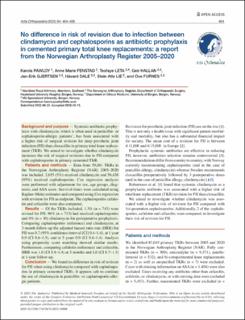| dc.contributor.author | Pawloy, Karola | |
| dc.contributor.author | Fenstad, Anne Marie | |
| dc.contributor.author | Leta, Tesfaye Hordofa | |
| dc.contributor.author | Hallan, Geir | |
| dc.contributor.author | Gjertsen, Jan-Erik | |
| dc.contributor.author | Dale, Håvard | |
| dc.contributor.author | Lie, Stein Atle | |
| dc.contributor.author | Furnes, Ove Nord | |
| dc.date.accessioned | 2023-10-06T12:33:04Z | |
| dc.date.available | 2023-10-06T12:33:04Z | |
| dc.date.created | 2023-09-29T14:38:35Z | |
| dc.date.issued | 2023 | |
| dc.identifier.issn | 1745-3674 | |
| dc.identifier.uri | https://hdl.handle.net/11250/3094976 | |
| dc.description.abstract | Background and purpose: Systemic antibiotic prophylaxis with clindamycin, which is often used in penicillin- or cephalosporin-allergic patients’, has been associated with a higher risk of surgical revision for deep prosthetic joint infection (PJI) than cloxacillin in primary total knee replacement (TKR). We aimed to investigate whether clindamycin increases the risk of surgical revisions due to PJI compared with cephalosporins in primary cemented TKR.
Patients and methods: Data from 59,081 TKRs in the Norwegian Arthroplasty Register (NAR) 2005–2020 was included. 2,655 (5%) received clindamycin and 56,426 (95%) received cephalosporins. Cox regression analyses were performed with adjustment for sex, age groups, diagnosis, and ASA score. Survival times were calculated using Kaplan–Meier estimates and compared using Cox regression with revision for PJI as endpoint. The cephalosporins cefalotin and cefazolin were also compared.
Results: Of the TKRs included, 1.3% (n = 743) were revised for PJI. 96% (n = 713) had received cephalosporins and 4% (n = 30) clindamycin for perioperative prophylaxis. Comparing cephalosporins (reference) and clindamycin, at 3-month follow-up the adjusted hazard ratio rate (HRR) for PJI was 0.7 (95% confidence interval [CI] 0.4–1.4), at 1 year 0.9 (CI 0.6–1.5), and at 5 years 0.9 (CI 0.6–1.4). Analysis using propensity score matching showed similar results. Furthermore, comparing cefalotin (reference) and cefazolin, HRR was 1.0 (CI 0.8–1.4) at 3 months and 1.0 (CI 0.7–1.3) at 1-year follow-up.
Conclusion: We found no difference in risk of revision for PJI when using clindamycin compared with cephalosporins in primary cemented TKRs. It appears safe to continue the use of clindamycin in penicillin- or cephalosporin-allergic patients. | en_US |
| dc.language.iso | eng | en_US |
| dc.publisher | Medical Journals Sweden | en_US |
| dc.rights | Navngivelse-Ikkekommersiell 4.0 Internasjonal | * |
| dc.rights.uri | http://creativecommons.org/licenses/by-nc/4.0/deed.no | * |
| dc.title | No difference in risk of revision due to infection between clindamycin and cephalosporins as antibiotic prophylaxis in cemented primary total knee replacements: a report from the Norwegian Arthroplasty Register 2005–2020 | en_US |
| dc.type | Journal article | en_US |
| dc.type | Peer reviewed | en_US |
| dc.description.version | publishedVersion | en_US |
| dc.rights.holder | Copyright 2023 the authors | en_US |
| cristin.ispublished | true | |
| cristin.fulltext | original | |
| cristin.qualitycode | 1 | |
| dc.identifier.doi | 10.2340/17453674.2023.16907 | |
| dc.identifier.cristin | 2180352 | |
| dc.source.journal | Acta Orthopaedica | en_US |
| dc.source.pagenumber | 404-409 | en_US |
| dc.identifier.citation | Acta Orthopaedica. 2023, 94, 404-409. | en_US |
| dc.source.volume | 94 | en_US |

